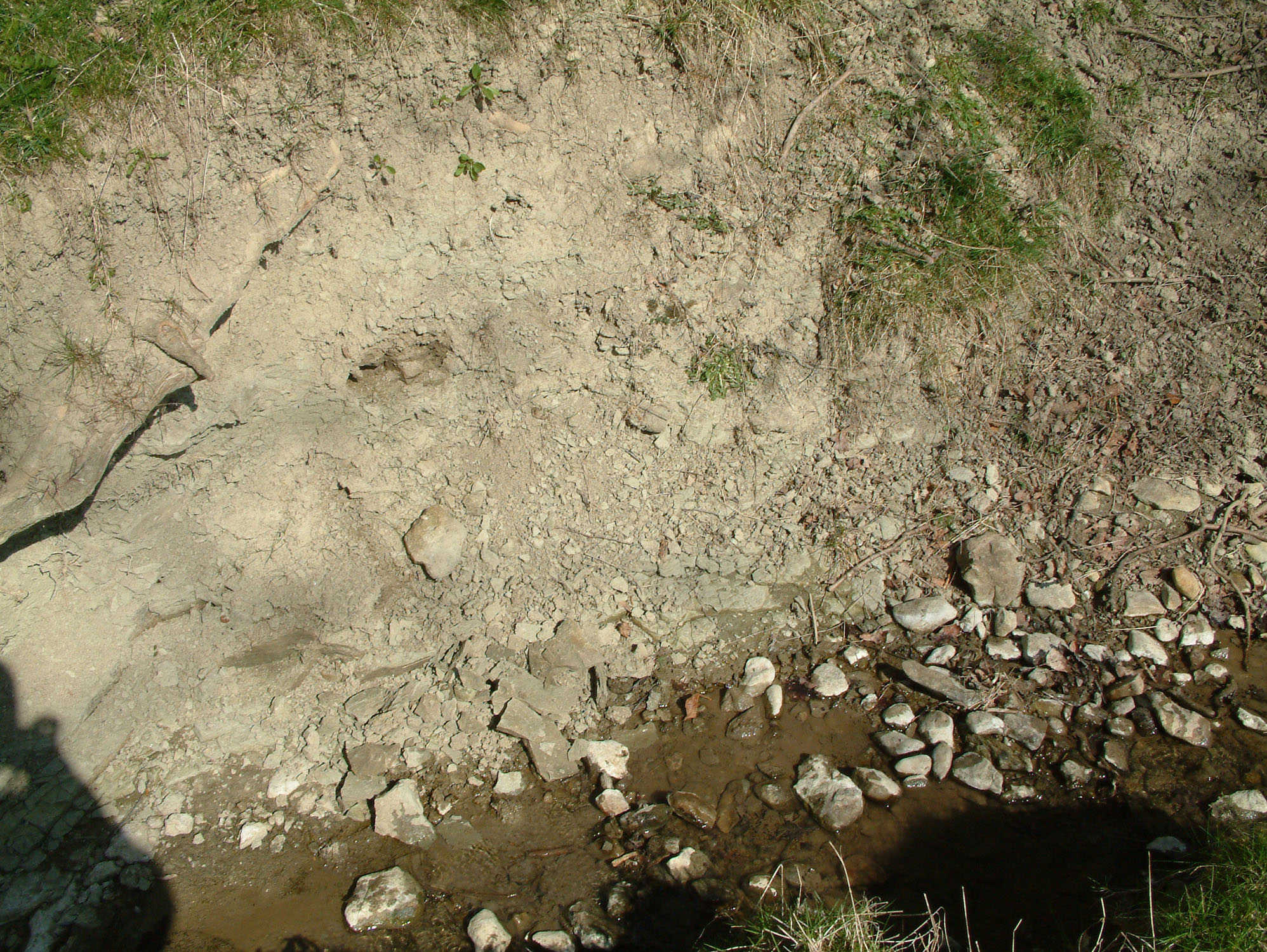This is a stream section, which has been cut back into highly fossiliferous Silurian rocks. Plenty of excellent corals can be found, along with brachiopods, bivalves and trilobites. Most of the fossils have been washed out from the rocks and are just lying in the stream.
DIRECTIONS
♦ Follow the B4371 towards Church Stretton and then, after about 3.5km, turn left heading towards Rushbury. Follow the road through Rushbury, which will then fork right at the top of a tree covered hill. About 1.5km further on, you will reach Millichope Farm. The farm is not signposted, but there is easy parking by the side of the road along a grass bank and you should notice a very small hill.
♦ A stream runs along the side of the road and there is an iron gate in the middle. There are trees running along the road by the stream. From the iron gate, you can walk in the stream to the left or right, or climb over the gate and walk left following the stream and edge of the field until you reach the small hill with an embankment.
♦ There is another location nearby, just 250m north of the farm. This can be more productive, but is also more sensitive to erosion, which has been quite bad in recent years. Care should be taken at this site to prevent further damage.
♦ Ref: 52.50384°N, 2.70941°W
PROFILE INFO
FIND FREQUENCY: ♦♦♦ – Upper Millichope has lots of fossils, but you must not hammer or dig into the riverbank.
CHILDREN: ♦ – This location is not suitable for children.
ACCESS: ♦♦♦ – It is easy to find, but it can be difficult to walk through the stream, especially after heavy rain when the stream is full.
TYPE: – Fossils are found in the stream.
FOSSIL HUNTING
At Upper Millichope, Silurian mudstones yield brachiopods, gastropods, graptolites and cephalopods, and this site is world famous for trilobites (Dalmanites and Calymene). You should also find many corals at the final part of this location. There are three main areas for collecting. At the iron gate, you can search the river bed on both sides. To the right, finer shingle yields many small brachiopods (especially Atrypa), which have been washed out of the mudstone, just waiting to be picked up.
The left hand side of the river starts to become courser with more rocks and a wider range of fossils. Follow the stream to where the stream splits into two and where there is a small water outfall on the left. Here, the stream becomes impassable because of fallen trees and a wire fence.
Do not hammer the bank nearest the road. You may collect from the bank next to the field and from the riverbed itself. The third part of this location is the most productive. You will need to backtrack to the iron gate, climb over the gate and walk left, keeping to the edge of the field. You will eventually come to the stream that splits into two and runs along the field. This is just beyond the furthest point that can be walked in the stream and beyond the wire fence. You will notice a small hill in front of you and a small bridge to your left. Search in the riverbank and in the riverbed up to where the stream runs under the farm track. You should find many corals here.
GEOLOGY
The beds here are Silurian period, of the Lower Ludlow epoch (Gorstian) with exposures from the Lower and Middle Elton Formation
This site shows a long stratigraphical section through the Lower Ludlow Shale, with the Lower and Middle Elton Formation, with a Lobograptus scanicus graptolite fauna. The fauna and flora suggest deposition of the calcareous siltstones here in comparatively deep water conditions.
The macrofauna present consists of well-preserved graptolites, trilobites and brachiopods. There are outcrops in the banks of the stream at intervals for several hundred meters up the stream from the bridge by the footpath. These are continually eroding so provide a plentiful supply of loose material in which to find the fossils mentioned.


SAFETY
There are no specific dangers at this location, but common sense and care should be used. It is probably best to take general hygiene precautions by ensuring that you wash your hands after collecting in this stream. Although rare and normally associated with sewers and stagnant water, Weil’s Disease has been known to be contracted from ditches and streams, and can be fatal. There is also some wire and sharp metal objects scattered along the stream, so care must be taken.
EQUIPMENT
Do not hammer the bank next to the road. Take a hammer and eye protection to split any rocks in the stream and a trowel to search in the mudstones. However, most fossils have been washed out of the beds and can be picked up often in perfect condition. A hammer and trowel should only be used if you actually see something in the rock or bedding. Fossils tend to be hard at this location, so they can be put into bags, but it is ideal to keep a small bag to put the brachiopods together, since you will probably find a large number of these.
ACCESS RIGHTS
This site is an SSSI. This means you can visit the site, but hammering the bedrock is not permitted. For full information about the reasons for the status of the site and restrictions please download the PDF from Natural England – SSSI Information – Upper Millichop
It is important to follow our ‘Code of Conduct’ when collecting fossils or visiting any site. Please also read our ‘Terms and Conditions‘
LINKS
♦ Buy Fossils, Crystals, Tools
♦ Location Discussions
♦ Deposits Magazine
♦ Join Fossil Hunts
♦ UK Fossils Network













































